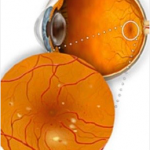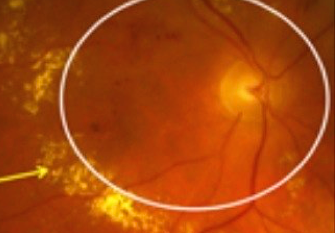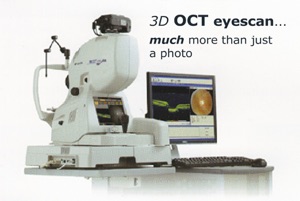What is diabetic retinopathy?
Diabetes mellitus or ‘sugar diabetes’ affects about one person in fifty in the UK. This means that the body cannot cope normally with sugar and other carbohydrates in the diet.
Diabetes can start in childhood, but more often it begins later in life. It can cause complications, which affect many different parts of the body. There are two types of diabetes mellitus – Type 1 is controlled by insulin injections and Type 2 by diet or tablets. Both Type 1 & 2 can affect the eyes in the same way.
If you have diabetes this does not necessarily mean that your site will be affected, but there is a higher risk. If your diabetes is well controlled then you are less likely to have problems, or they may be less serious. However, if there are complications which affect the eyes then this can result in loss of sight. These complications are called ‘diabetic retinopathy’.
 Most sight loss from diabetic retinopathy can be prevented. But it is vital that it is diagnosed early. You may not realise that there is anything wrong with your eyesight, and so regular eye checks are the only way to detect any potential eye problems.
Most sight loss from diabetic retinopathy can be prevented. But it is vital that it is diagnosed early. You may not realise that there is anything wrong with your eyesight, and so regular eye checks are the only way to detect any potential eye problems.
How can diabetes affect the eye?
The human eye has a lens and a pupil (an aperture) at the front, which focuses the light onto the retina at the back of the eye. The retina is made up of a delicate tissue that is sensitive to light, rather like the film in a camera.
At the centre of the retina is the macula, which is a small area about the size of a pinhead. This is the most highly specialised part of the retina (it allows high definition-HD vision) and it is vital because it enables you to see fine detail and therefore read small print. The other parts of the retina give you side vision (peripheral vision). Filling the cavity of the eye in front of the retina is a clear jelly-like substance called the ‘vitreous’.
Diabetes can affect the eye in a number of ways. These usually involve the small fine network of blood vessels in the retina – hence the term ‘diabetic retinopathy’. There are a number of different stages in the development of diabetic retinopathy.
The different stages of diabetic retinopathy
Background diabetic retinopathy
This condition is very common in people who have had diabetes for a long time. Your optometrist may be able to see abnormalities in your eyes, but there is no threat to your sight.
There are two types of diabetic retinopathy which can damage your sight permanently. This happens when the blood vessels in the retina start to leak. They are described below.
Maculopathy
If the macula is affected, you will find that your central vision gradually gets worse in one or both eyes. You may find it difficult to recognise people’s faces in the distance or to see detail such as small print. The amount of central vision that is damaged varies from person to person. However, the vision which allows you to get around at home and outside (navigation vision) will be unaffected.
It is very rare for someone with maculopathy to lose all of his or her sights.
Proliferative diabetic retinopathy
Sometimes diabetes can cause the blood vessels in the retina to become blocked. If this happens then new blood vessels form in the eye. This is nature’s way of trying to repair the damage so that the retina has a new blood supply.
Unfortunately, these new blood vessels are weak. They are also in the wrong place – growing on the surface of the retina and into the vitreous. Consequently, these blood vessels can bleed very easily and cause scar tissue to form in the eye. The scarring pulls and distorts the retina. When the retina is pulled out of position this is called retinal detachment.
Proliferative retinopathy is rarer than background retinopathy and is more often found in people who have been insulin-dependent for many years.
The new blood vessels will rarely affect your vision, but their consequences, such as bleeding or retinal detachment can cause your vision to get worse suddenly.
Your eyesight may become blurred and patchy as the bleeding obscures part of your vision.
Without treatment, total loss of vision can happen in proliferative retinopathy.
With treatment, most sight-threatening diabetic problems can be prevented if caught early enough.
Temporary blurring
Your vision may become blurred for a few days or weeks after you are diagnosed and while your diabetes is first being brought under control. This can due to the swelling of the lens of the eye and will soon clear without treatment after the diabetes is stabilised.
One other cause of temporary blurring is ‘macular oedema’ this condition is often the earliest sign of diabetic retinopathy and is caused by early swelling of the macula which can increase and decrease over days and weeks. Early detection of macular oedema can be made using the OCT eye scan giving advance warning of the onset of more serious diabetic retinopathy.
Cataracts
Cataracts are a very common side effect of having diabetes. They can occur in both Type 1 and Type 2 forms of the disease. They are more likely to occur in long term diabetics or those who have poor control of their condition. Cataracts can usually be successfully removed by surgery when an intraocular implant lens is inserted inside the eye to replace the hazy natural lens which is removed.
The importance of early treatment
Although your vision may be good, changes can be taking place to your retina that needs treatment. And because most sight loss in diabetes is preventable:
- early diagnosis is vital.
- have an eye examination every year.
- do not wait until your vision has deteriorated to have an eye test.
If a problem is found by your optometrist you will be referred to an eye surgeon or ophthalmologist at a hospital eye clinic.
Remember, however, that if your vision is getting worse, this does not necessarily mean you have diabetic retinopathy. It may simply be a problem that can be corrected by glasses.
What is the treatment?
Most sight-threatening diabetic problems can be prevented by the use of Argon laser treatment if it is applied early enough. It is important to realise, however, that laser treatment aims to save the sight you have – not to make it better. The laser, a beam of high-intensity light, can be focused with extreme precision, so the blood vessels that are leaking fluid into the retina can be sealed.
If new blood vessels are growing (as in proliferative retinopathy), more extensive laser treatment has to be carried out. In eight out of ten cases laser treatment causes the new blood vessels to disappear.
How is laser treatment carried out?
All treatment is carried out by an eye surgeon or ophthalmologist in an outpatient clinic of your local hospital. Eye drops are used to enlarge the pupils so that the eye specialist can look into your eyes. The eyes are then numbed with drops and a special contact lens is put onto your eye to stop it blinking. You will be asked to move your eyes in certain directions but this can easily be done with the contact lens in place.
Is it painful?
The treatment for sealing blood vessels doesn’t usually cause any discomfort. However, the treatment to remove new blood vessels can be a bit uncomfortable so you may be given a pain-relieving tablet at the same time as the eyedrops. If the treatment does become painful, then it is possible to have an injection around the eye to numb the pain.
Does laser treatment have any side effects?
The treatment for sealing blood vessels has few side effects, although you may lose a little central vision or notice the laser burns as small blank spots.
Laser treatment to remove new blood vessels is more complicated and there may be more side effects. It is quite common to lose some vision to the sides (peripheral vision), and this may mean that you will not be able to drive in future. Night and colour vision may also be reduced. Occasionally your central vision may not be as good as before so that print isn’t as easy to see.
No treatment is possible without some side effects. But the risks of laser treatment are far less than the risks of not having treatment.
Further help and information
10 Parkway, London, NW1 7AA
Telephone 020 7424 1000
Diabetes UK is the largest organisation in the UK working for people with diabetes, funding research, campaigning and helping people to live with the condition.
The Partially Sighted Society offers information and advice, publications, aids to vision, enlargement services and local support to help you make the most of your vision.
Queen’s Road
Doncaster
DN1 2NX
Telephone 01302 323 132



